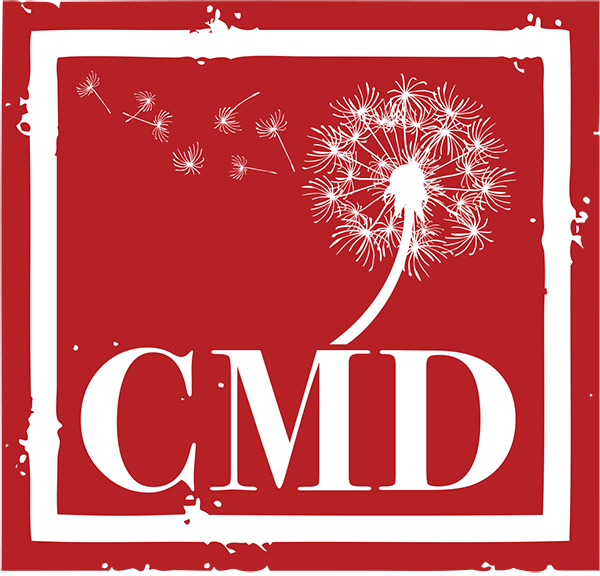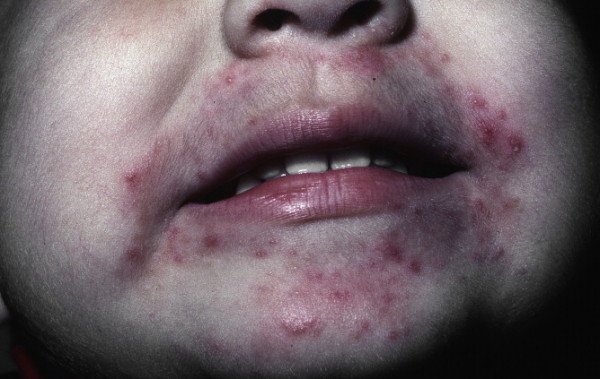That Rash Around Your Mouth Might Be Perioral Dermatitis
Our most widely-read post on this blog is about a rash I had around my mouth and how I discovered what triggered it and how I finally healed it. That particular rash was the result of an allergic reaction to propolis. But not all rashes near the mouth or on the face are caused by allergic contact dermatitis. Sometimes they are the result of a condition called perioral dermatitis. Differentiation of mouth/face rashes is important because the treatments for allergic contact dermatitis, acne, rosacea, or eczema can make perioral dermatitis worse.
Appearance of Perioral Dermatitis:
The most common presentation of perioral dermatitis is at the corner of the nose or along the nasolabial folds.
Copyright © 2012 Elsevier Inc.
Perioral dermatitis is a non-contagious skin condition that occurs mostly in women (typically ages 16 to 45) and sometimes in children. The etiology and pathogenesis is unknown according to western biomedicine. The rash of perioral dermatitis is rather distinct though it can often be misdiagnosed as eczema (atopic dermatitis), acne, allergic contact dermatitis, or even rosacea. Eruptions typically begin around the mouth (perioral region) in the nasolabial folds (smile lines) and can spread to the sides of the nose (perinasal region), the chin, the cheeks, or even the lateral aspect of the lower eyelid (periorbital region). Sometimes the rash only appears at the eyelids (despite the name “perioral” dermatitis). Tiny papules (small bumps) and small vesicles (bumps filled with a small amount of clear fluid) will appear on an erythematous (red) base. Sometimes there is also dry scaling. The skin may feel tight and dry with occasional mild itching or burning. Most of the time the rash will be symmetrical – appearing on both sides of the face.
Differentiation:
Acne: When perioral dermatitis affects the chin and the skin next to the nose, it often looks like acne at first appearance. But you can tell that it is not acne by noticing there are no comedones (blackheads or whiteheads).
This case of perioral dermatitis resembles acne.
Copyright © 2012 Elsevier Inc.
Allergic Contact Dermatitis: Allergic reactions around the mouth or lips, like from lip balms or lipstick, will also typically affect the vermilion border (the edge between your lips and the regular skin of your face). In the case of perioral dermatitis, this vermilion border is spared and there will be a thin clear zone along the edge of the lips with no redness or papules.
Eczema (Atopic Dermatitis): It can be challenging to differentiate perioral dermatitis from eczema/AD at first glance. Eczema will often appear elsewhere on the face or the body and not be confined to the region around the mouth or eyes. Eczema/AD can be asymmetrical, while perioral dermatitis is typically symmetrical. Blood tests for IgE levels can be helpful to determine if it is eczema/AD. Often topical steroids will be prescribed to treat the eczema but this can cause a severe aggravation of the eruptions if it truly is perioral dermatitis.
This infant’s rash was initially misdiagnosed as eczema and treated with topical steroids which made the rash worse.
Copyright © 2012 Elsevier Inc.
Rosacea: At the initial stages of rosacea, flushing occurs and erythema can occur without papules or pustules (though these appear at later stages). Rosacea can also affect the forehead and nose (unlike perioral dermatitis) and is usually more wide-spread on the cheeks. Telangiectasia (dilated purple capillaries) appears in rosacea but not in perioral dermatitis. Rosacea is not seen in young children.
Why Does Perioral Dermatitis Occur?
Despite the name, “perioral” dermatitis can occur exclusively at lateral aspect of the eyes.
Copyright © 2012 Elsevier Inc.
While the exact cause of this condition is unknown (according to biological science), it is often triggered by the use of potent (fluorinated) topical steroids on the face or elsewhere on the body. Perioral dermatitis eruptions appear on the delicate areas of the face where drying substances (like benzoyl peroxide found in acne medications) make the skin too dry. It is believed that in individuals with constitutionally dry skin, the overuse of moisturizers causes the surface of the skin (the horny layer) to be constantly artificially hydrated, thus affecting this layer’s ability to inhibit the growth of bacteria. This is thought to play a role in the development of perioral dermatitis. Case studies show that the use of moisturizers plus cosmetic foundation on a daily basis contributes to an increased risk of developing perioral dermatitis. Persons with oily skin who do not properly cleanse with water and soap (or other cleanser) are also susceptible. Daily use of heavy sunscreens also tend to trigger this type of rash.
In the last few months I have had 8 new patients contact me regarding perioral dermatitis. All but one of them were women who worked in healthcare (nurses, acupuncturists, and optometrists). They all claim to have had no contact with steroid creams and they appear to wear minimal amounts of makeup (if any). Perhaps there is a common chemical or cleanser they are coming into contact with that is triggering this? Not an allergy but maybe a chemical irritant? In each of these cases, the rash improves on days when the patient is not at work or when they are on vacation and it reappears or gets noticeably worse when they return to work. I am so curious to discover the correlation here (if one exists).
How To Treat Perioral Dermatitis:
In most cases, perioral dermatitis responds quite well to treatment, though there are times where is recurs or becomes stubborn (like in the health care workers mentioned above). Oral (internal) antibiotics are the treatment of choice in western dermatology. Internal herbs are the treatment of choice in Traditional Chinese Dermatology. Whether or not internal treatments are sought, the following must be considered:
Stop the use of all steroid creams (on the face as well as elsewhere on the body). If you have been using a steroid cream, your rash may get worse when you first withdraw the substance but be patient…this will clear up in most cases.
Discontinue the application of all moisturizers on the face. Even after the rash resolves, you should not apply moisturizers on the areas where the rash was or it may recur.
Discontinue (or at least limit) the use of sunscreens on the face. (But then be sure to stay out of the sun or wear a hat with a large brim). If you must be out in the sun, choose a sunscreen that is a liquid or gel (not a lotion/cream which is oil-based).
Do not use moisturizer under your cosmetic foundation. And limit your use of cosmetics in general.
Wash face with just warm water until the eruptions resolve, then use a gentle cleanser or soap to keep your face clean.
Avoid using drying alcohol-based facial toners or cleansers.
Avoid using drying acne medications such as those that contain benzoyl peroxide.
Do not touch your face. Seriously, don’t keep checking the feel of the rash to see if it is improving. And try to stay of aware if you are inadvertently touching your face throughout the day (rubbing your chin in thought, scratching little itches, etc.).
Make sure your pillow case is clean.
Avoid spicy and/or greasy food. From the TCM perspective these foods aggravate the energetic imbalances that lead to facial rashes of many varieties.
From a western medicine perspective:
My colleague, a nurse practitioner specializing in dermatology, suggests doxycycline 50 mg BID to clear it initially. Follow with 50 mg daily for 2 more weeks to assure it stays gone. This will not prevent it from recurring, but it should clear up the current episode.
Do you have or think you have perioral dermatitis? Share your experience with us by commenting below. I would really love to hear from health care providers to see if there is any link to those work environments and the development of this condition.




